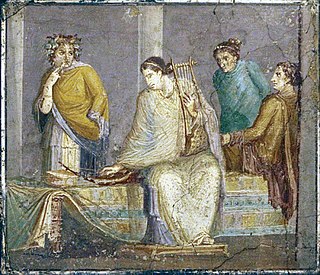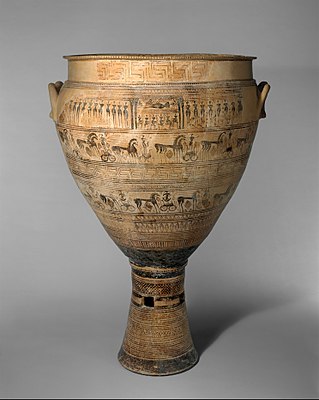A paean is a song or lyric poem expressing triumph or thanksgiving. In classical antiquity, it is usually performed by a chorus, but some examples seem intended for an individual voice (monody). It comes from the Greek παιάν, "song of triumph, any solemn song or chant". "Paeon" was also the name of a divine physician and an epithet ("byname") of Apollo.

The lyre is a stringed musical instrument that is classified by Hornbostel–Sachs as a member of the lute-family of instruments. In organology, a lyre is considered a yoke lute, since it is a lute in which the strings are attached to a yoke that lies in the same plane as the sound table, and consists of two arms and a crossbar.

Abellio was a god worshiped in the Garonne Valley in Gallia Aquitania, known primarily by a number of inscriptions which were discovered in Comminges, in the Pyrenees. He may have been a god of apple trees or the sun.

Beli Mawr was an ancestor figure in Middle Welsh literature and genealogies. He is the father of Cassivellaunus, Arianrhod, Lludd Llaw Eraint, Llefelys, and Afallach. In certain medieval genealogies he is listed as the son or husband of Anna, cousin of Mary, mother of Jesus. According to the Welsh Triads, Beli and Dôn were the parents of Arianrhod, but the mother of Beli's other children—and the father of Dôn's other children—is not mentioned in the medieval Welsh literature. Several royal lines in medieval Wales traced their ancestry to Beli. The Mabinogi names Penarddun as a daughter of Beli Mawr, but the genealogy is confused; it is possible she was meant to be his sister rather than daughter.
Iago ap Beli was King of Gwynedd. Little is known of him or his kingdom from this early era, with only a few anecdotal mentions of him in historical documents.
Carcinus was an Ancient Greek tragedian from Thoricus, the son of the playwright Xenocles and grandson of Carcinus. The Suda records that he wrote one hundred and sixty plays. He won eleven victories at the Dionysia. His exact dates are uncertain, though he was certainly active in the 370s BC. According to the Suda, his floruit was in the 100th Olympiad ; and his first victory at the Dionysia can be dated to before 372. Dionysius II of Syracuse was a patron of Carcinus. Nine or ten titles of his plays are known: Aerope, Ajax, Alope, Amphiaraus, Medea, Oedipus, Orestes, Semele, Thyestes, and possibly Tyro. His work survives only in fragments.
Mesomedes of Crete was a Greek citharode and lyric poet and composer of the early 2nd century AD in Roman Greece. Prior to the discovery of the Seikilos epitaph in the late 19th century, the hymns of Mesomedes were the only surviving written music from the ancient world. Three were published by Vincenzo Galilei in his Dialogo della musica antica e della moderna, during a period of intense investigation into music of the ancient Greeks. These hymns had been preserved through the Byzantine tradition, and were presented to Vincenzo by Girolamo Mei.

The Delphic Hymns are two musical compositions from Ancient Greece, which survive in substantial fragments. They were long regarded as being dated c. 138 BC and 128 BC, respectively, but recent scholarship has shown it likely they were both written for performance at the Athenian Pythaides in 128 BC. If indeed it dates from ten years before the second, the First Delphic Hymn is the earliest unambiguous surviving example of notated music from anywhere in the western world whose composer is known by name. Inscriptions indicate that the First Delphic Hymn was written by Athenaeus, son of Athenaeus, while Limenius is credited the Second Delphic Hymn's composer.
Limenius was an Athenian musician and the creator of the Second Delphic Hymn in 128 BC. He is the earliest known composer in recorded history for a surviving piece of music, or one of the two earliest, or the second-earliest, depending first on whether one accepts the proposition of Bélis that the composer of the First Delphic Hymn is named Athenaeus and, second, whether that hymn was composed in the same year as the Second Hymn, or ten years earlier. Limenius was a performer on the kithara and, as a professional musician performing in the Pythaïs, he was required to belong to one of the guilds of the Artists of Dionysus.

The Timok, sometimes also known as Great Timok, is a river in eastern Serbia, a right tributary of the Danube. For the last 15 km of its run it forms a border between eastern Serbia and western Bulgaria.
The Oxyrhynchus hymn is the earliest known manuscript of a Christian Greek hymn to contain both lyrics and musical notation. The papyrus on which the hymn was written dates from around the end of the 3rd century AD. It is on Papyrus 1786 of the Oxyrhynchus papyri, now kept at the Papyrology Rooms of the Sackler Library, Oxford. The manuscript was discovered in 1918 in Oxyrhynchus, Egypt, and later published in 1922.

Music was almost universally present in ancient Greek society, from marriages, funerals, and religious ceremonies to theatre, folk music, and the ballad-like reciting of epic poetry. This played an integral role in the lives of ancient Greeks. There are some fragments of actual Greek musical notation, many literary references, depictions on ceramics and relevant archaeological remains, such that some things can be known—or reasonably surmised—about what the music sounded like, the general role of music in society, the economics of music, the importance of a professional caste of musicians, etc.

The music of ancient Rome was a part of Roman culture from the earliest of times. Songs (carmen) were an integral part of almost every social occasion. The Secular Ode of Horace, for instance, was commissioned by Augustus and performed by a mixed children's choir at the Secular Games in 17 BC. Music was customary at funerals, and the tibia, a woodwind instrument, was played at sacrifices to ward off ill influences. Under the influence of ancient Greek theory, music was thought to reflect the orderliness of the cosmos, and was associated particularly with mathematics and knowledge.

A clapper is a basic form of percussion instrument. It consists of two long solid pieces that are struck together producing sound. A straightforward instrument to produce and play, they exist in many forms in many different cultures around the world. Clappers can take a number of forms and be made of a wide variety of material. Wood is most common, but metal and ivory have also been used. The plastic thundersticks that have recently come to be popular at sporting events can be considered a form of inflated plastic clapper.

The Seven Wonders of the Ancient World, also known as the Seven Wonders of the World or simply the Seven Wonders, is a list of seven notable structures present during classical antiquity. The first known list of seven wonders dates back to the 2nd–1st century BC.

The kithara, or Latinized cithara, was an ancient Greek musical instrument in the yoke lutes family. It was a seven-stringed professional version of the lyre, which was regarded as a rustic, or folk instrument, appropriate for teaching music to beginners. As opposed to the simpler lyre, the cithara was primarily used by professional musicians, called kitharodes. In modern Greek, the word kithara has come to mean "guitar", a word which etymologically stems from kithara.
Athenaeus, son of Athenaeus was an ancient Greek (Athenian) composer and musician who flourished around 138–128 BC, when he composed the First Delphic Hymn. Although it was long thought that the composer of the First Hymn was merely "an Athenian", careful reading of the inscription shows that it cannot be the ethnic Athenaîos, but rather names Athénaios Athenaíou as the composer.
2nd millennium BC in music - 1st millennium BC in music - 1st millennium in music
Annie Bélis is a French archaeologist, philologist, papyrologist and musician. She is a research director at the French CNRS, specialized in music from classical antiquity, Ancient Greece and Ancient Rome.

Dipylon kraters are Geometric Period Greek terracotta funerary vases found at the Dipylon cemetery; near the Dipylon Gate, in Kerameikos. Kerameikos is known as the ancient potters quarter on the northwest side of the ancient city of Athens and translates to "the city of clay." A krater is a large Ancient Greek painted vase used to mix wine and water, but the large kraters at the Dipylon cemetery served as grave markers.











